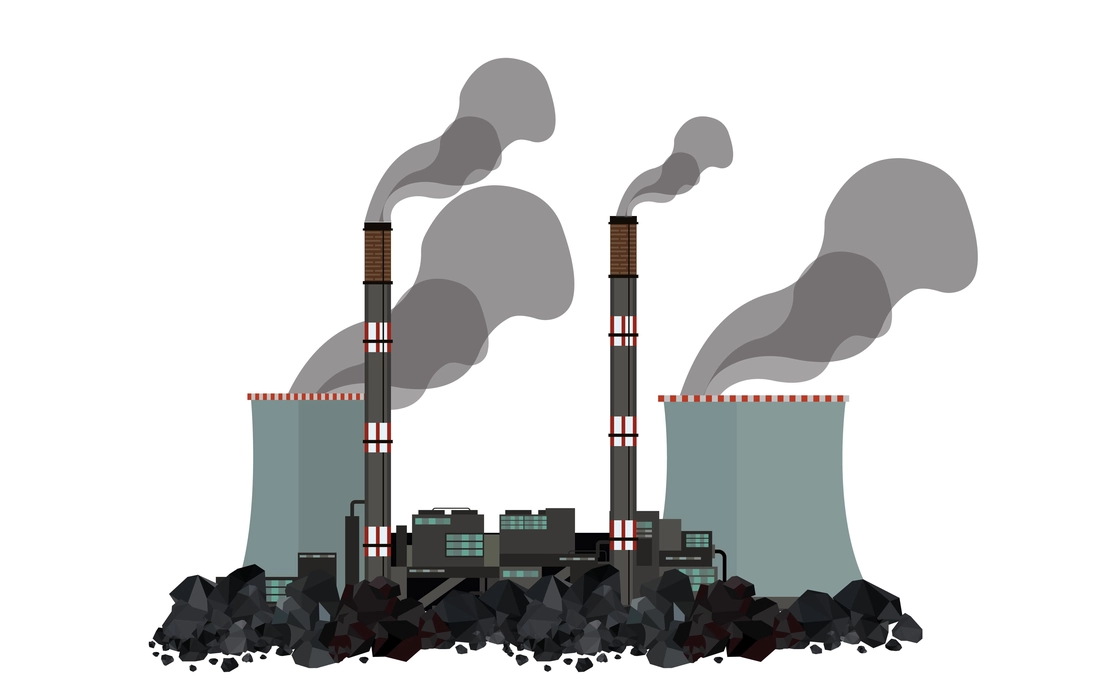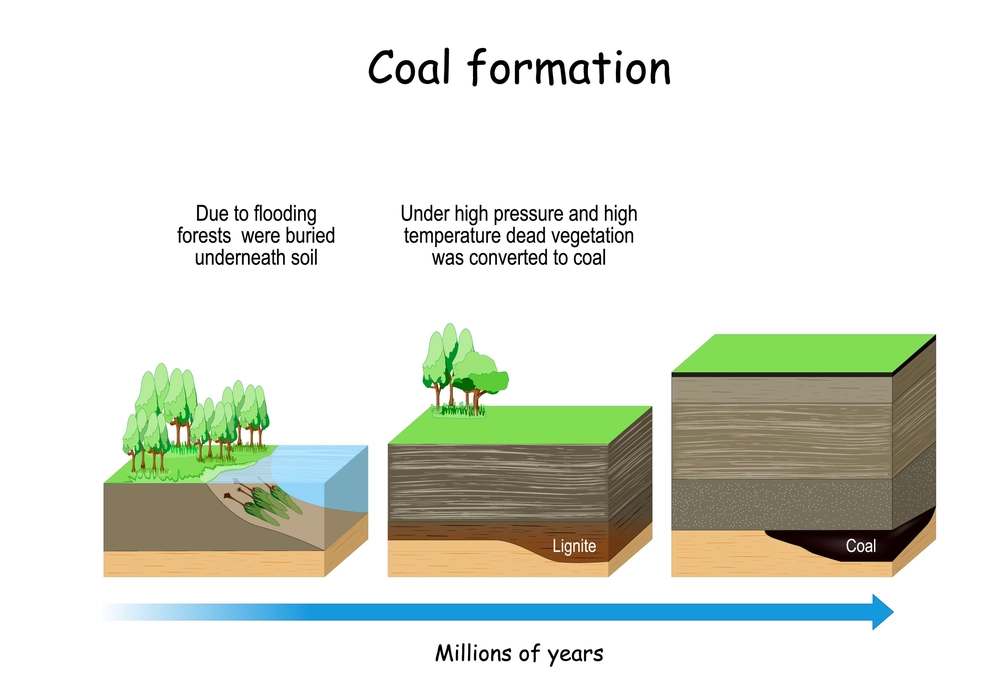Introduction
Fossil fuels are hydrocarbon (compounds of carbon and hydrogen)-containing substances that form naturally (in nature) on the earth’s surface (earth’s crust). They are made up of the remains of dead (not alive) plants (flora) and animals (fauna) that are extracted (absorbed) and buried under the soil before being burned as fuel. Coal, petroleum, and natural gas are examples of well-known and widely used fossil fuels (or fuels). Coal seams are rock strata (stone) that form coal (charcoal) seams. When dead (not alive) plant matter (flora) decays (decomposes) into peat (an accumulation of partially decayed organisms), it is converted (transformed) into coal (charcoal) by heat (H) and pressure (P).
There are four stages involved in coal generation or formation:
- Peat
- Lignite
- Bituminous
- Anthracite
These stages (steps) are determined by the conditions in which they were buried. Coal has many applications in our lives, including home and commercial heating, the production of medicines and tars, and so on. Petroleum (also known as crude oil) is formed or produced from the decomposing remains of ancient marine organisms like bacteria, plants, and algae. Petroleum is used to produce heat and electricity, as well as a lubricant.
Let our expert Guru be your guide toward improving your grades and reaching your highest potential. Study Science curriculum for classes 8th Lesson No. 5
What exactly are fossil fuels?
Fossil fuel is a type of hydrocarbon-containing substance that occurs or is produced naturally on the earth’s surface from the dead remains of plants and animals, which are extracted and burned as fuel. Coal, petroleum, and natural gas are three of the most common and widely used fossil fuels. Fossil fuels are sometimes burned to provide heat for direct use in cooking and heating. Additionally, fossil fuels are used to power engines and generate electricity.
The anaerobic decomposition of buried dead organisms containing organic-type molecules generated by photosynthesis is the origin of fossil fuels. And the conversion of these substances to fossil fuels necessitates or is the result of a geological process that takes millions of years. Fossil fuels are extremely important for humanity and development because they can be easily burned in the open atmosphere to produce heat. However, the excessive use or exploitation of fossil fuels by humans is also very harmful to the environment.

How Is Coal Made?
Coal is a black, solid, combustible fossil fuel. Coal contains a significant amount of carbon. Coal formation is a slow and gradual process that takes millions of years. And coal formation begins or begins in muddy wetlands where groundwater is near or slightly above the topsoil. Because of this condition, the flora presents there produces organic matter at a faster rate. The layers of organic materials are then accumulated and buried. These layers combine to form coal. The energy in coal is derived from sunlight, which is harvested by dead plants.
Although there are two major stages in the formation of coal, they are peatification and coalification. Peat (accumulation of partially decayed organisms) formation occurs as a result of bacterial activities, and the main factors in coalification are exceeding temperature and pressure from burial.

Coal Formation Stages
There are four stages in the coal formation and, they are peat, lignite, bituminous, and anthracite. These stages are determined by the conditions to which the remains (plant) are subjected (forced) after being placed inside or buried. The higher the ranking of coals, the greater the amount of heat and pressure applied.
- Peat is the first stage in the formation of coal. In general, plant matter is oxidized to carbon dioxide (CO2) and water (H2O). However, if plant materials accumulate underwater (inside the water), oxygen (O2) is not available or present, and only partial (slight) decomposition occurs. This incomplete (partial) destruction (decomposition) results in the accumulation of peat, an organic (natural) substance (material).
- The lignite-The second stage of coal formation, in which peat (first step) is subjected (forced) to increase vertical pressure (p) from collecting sediments. It is widely available, but it is only used as coal when a more (higher) efficient fuel (fossil) is unavailable.
- Bituminous-The third stage in the formation of coal. Adding pressure, compacting (small area), and virtually (mostly) all traces of flora (plant life) have vanished or vanished. This type of coal can be found in Cape Breton and is also present in our most abundant fuel.
- Anthracite-This is the fourth and final stage in the formation of coal. This is also known as ‘hard coal,’ because it is hard (strong) and has a high luster. The combination of high pressure and temperature causes this to form.
Coal Applications
- Coal is used for a variety of purposes, including domestic and industrial fuel.
- Electricity is generated or produced using this device.
- It is also used as a fuel in automobiles.
- It is used in the manufacture or preparation of cement, carbon fibers, medicines, and other products.
- Furthermore, it’s also used in the steel industry to make steel and other metals.
Summary
Fossil fuel is a type of hydrocarbon-containing substance that occurred or is produced naturally on the earth’s surface from the dead remains of plants and animals, which are extracted and burned as fuel. Coal, petroleum, and natural gas are three of the most common and widely used fossil fuels. Fossil fuels are sometimes burned to provide heat for direct use in cooking and heating. Additionally, fossil fuels are used to power engines and generate electricity.
Frequently Asked Questions (FAQs)
1. What exactly do you mean by “fossil fuels”?
Ans. Fossil fuels are hydrocarbon-containing substances (materials) that formed naturally (in nature) on the earth’s surface (earth’s crust). They are made up of the remains (leftovers) of dead plants and animals that are extracted, buried, and burned as fuel.
2. What causes the production of fossil fuels?
Ans. The anaerobic (in the absence of oxygen) decomposition of buried dead organisms is the origin (point of generation) of fossil fuels (plants or animals).
3. Name the stages of coal formation.
Ans. The four stages of coal formation are peat, lignite, bituminous, and anthracite.
 Mission Statement
Mission Statement
“Empower every student to achieve full potential”
88Guru has been established with the social objective of making quality video-based learning material available to all Indian students. Technology, Connectivity and Social Media are rapidly changing the world of Education and we wish to lead the transformation of the tuition industry in India.
88Guru is the perfect complement to the current tuition model. 88Guru creates a wonderful opportunity for children and parents to bond while engaging in a valuable learning activity. It also provides the complete curriculum at your fingertips for those moments when you need some help at short notice. We believe that this mode of tuition could be transformational, adding hours to a child's day while providing complete control over the learning process.
Every course is taught by the best teachers from India's top schools and conducted in an engaging manner to keep students involved. The e-learning process consists of video-based instructions, computer-graded assignments, and a dashboard which allows the student and parent to track progress.



